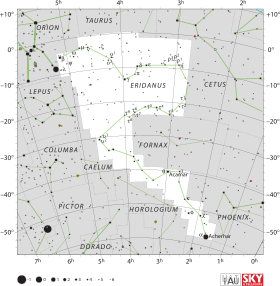Zeta Eridani
étoile binaire spectroscopique de la constellation de l'Éridan
(Redirigé depuis Zibal)
ζ Eridani
Zibal
Zibal
| Ascension droite | 03h 15m 50,02537s[1] |
|---|---|
| Déclinaison | −08° 49′ 11,0262″[1] |
| Constellation | Éridan |
| Magnitude apparente | 4,80[2] |
Localisation dans la constellation : Éridan | |
| Type spectral | kA4hA9mA9V[3] |
|---|---|
| Indice U-B | +0,07[2] |
| Indice B-V | +0,24[2] |
| Vitesse radiale | −5,8 ± 4,2 km/s[4] |
|---|---|
| Mouvement propre |
μα = −2,528 mas/a[1] μδ = +46,193 mas/a[1] |
| Parallaxe | 28,338 1 ± 0,248 5 mas[1] |
| Distance | 35,288 2 ± 0,309 4 pc (∼115 al)[1] |
| Magnitude absolue | 1,97[5] |
| Masse | 1,85 M☉[6] |
|---|---|
| Rayon | 10,3 R☉[6] |
| Gravité de surface (log g) | 4,05[6] |
| Luminosité | 10,3 L☉[7] |
| Température | 7 575 K[6] |
| Métallicité | 0,04[6] |
| Rotation | 82 km/s[5] |
| Âge | 800 Ma[8] |
| Excentricité (e) | 0,14 ± 0,03 |
|---|---|
| Période (P) | 17,929 7 ± 0,003 9 j |
| Argument du périastre (ω) | 122 ± 11° |
| Époque du périastre (τ) | 43 051,07 ± 0,83 JJ |
| Demi-amplitude (K1) | 21,5 ± 0,6 km/s |
Désignations
Zeta Eridani (ζ Eridani / ζ Eri), également nommée Zibal, est une étoile binaire de la constellation de l'Éridan. Sa magnitude apparente est de 4,8 et elle se situe à ∼ 115 a.l. (∼ 35,3 pc) du Soleil[1].
Zeta Eridani est un système binaire spectroscopique à raies simples[10] avec une période orbitale de 17,9 jours et une excentricité de 0,14[5]. Son étoile visible est une étoile blanche de la séquence principale et une étoile Am de type spectral kA4hA9mA9V[3]
Zibal, le nom traditionnel de Zeta Eridani, a été officialisé par l'Union astronomique internationale le [11].
Notes et références modifier
- (en) A. G. A. Brown et al. (Gaia collaboration), « Gaia Data Release 2 : Summary of the contents and survey properties », Astronomy & Astrophysics, vol. 616, , article no A1 (DOI 10.1051/0004-6361/201833051, Bibcode 2018A&A...616A...1G, arXiv 1804.09365). Notice Gaia DR2 pour cette source sur VizieR.
- (en) J.-C. Mermilliod, « Compilation of Eggen's UBV data, transformed to UBV (unpublished) », Non publié, SIMBAD, (Bibcode 1986EgUBV........0M)
- (en) R. O. Gray, C. J. Corbally, R. F. Garrison, M. T. McFadden, E. J. Bubar, C. E. McGahee, A. A. O'Donoghue et E. R. Knox, « Contributions to the Nearby Stars (NStars) Project: spectroscopy of stars earlier than M0 within 40 pc-The Southern Sample », The Astronomical Journal, vol. 132, no 1, , p. 161–170 (DOI 10.1086/504637, Bibcode 2006AJ....132..161G, arXiv astro-ph/0603770)
- (en) G. A. Gontcharov, « Pulkovo Compilation of Radial Velocities for 35 495 Hipparcos stars in a common system », Astronomy Letters, vol. 32, no 11, , p. 759–771 (DOI 10.1134/S1063773706110065, Bibcode 2006AstL...32..759G)
- (en) I. Kh. Iliev, J. Budaj, M. Feňovčík, Stateva, I. et Richards, M. T., « Abundance analysis of Am binaries and search for tidally driven abundance anomalies - II. HD861, HD18778, HD20320, HD29479, HD96528 and HD108651 », Monthly Notices of the Royal Astronomical Society, vol. 370, no 2, , p. 819−827 (DOI 10.1111/j.1365-2966.2006.10513.x, Bibcode 2006MNRAS.370..819I)
- (en) Nicole Pawellek, Alexander V. Krivov, Jonathan P. Marshall, Benjamin Montesinos, Péter Ábrahám, Attila Moór, Geoffrey Bryden et Carlos Eiroa, « Disk Radii and Grain Sizes in Herschel-resolved Debris Disks », The Astrophysical Journal, vol. 792, no 1, , p. 19 (DOI 10.1088/0004-637X/792/1/65, Bibcode 2014ApJ...792...65P, arXiv 1407.4579)
- (en) I. McDonald, A. A. Zijlstra et M. L. Boyer, « Fundamental Parameters and Infrared Excesses of Hipparcos Stars », Monthly Notices of the Royal Astronomical Society, vol. 427, no 1, , p. 343–57 (DOI 10.1111/j.1365-2966.2012.21873.x, Bibcode 2012MNRAS.427..343M, arXiv 1208.2037)
- Laura Vican, « Age Determination for 346 Nearby Stars in the Herschel DEBRIS Survey », The Astronomical Journal, vol. 143, no 6, , p. 135 (DOI 10.1088/0004-6256/143/6/135, Bibcode 2012AJ....143..135V, arXiv 1203.1966)
- (en) * zet Eri -- Spectroscopic binary sur la base de données Simbad du Centre de données astronomiques de Strasbourg.
- (en) Helmut A. Abt, « MK Classifications of Spectroscopic Binaries », The Astrophysical Journal Supplement, vol. 180, no 1, , p. 117–118 (DOI 10.1088/0067-0049/180/1/117, Bibcode 2009ApJS..180..117A)
- (en)IAU Catalog of Star Names
Lien externe modifier
- (en) Zeta Eridani sur la base de données Simbad du Centre de données astronomiques de Strasbourg.
- (en) Bright Star Catalogue, « Zeta Eridani », sur Alcyone
